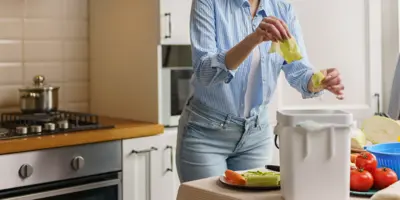
Strolling through the supermarket aisles with an eco-conscious heart doesn't mean your wallet needs to bleed green too – unless we're talking about eco-friendly choices, of course! Eco-friendly shopping is all about finding joy in the amongst the cans, cartons, and compostables, so let’s embrace making eco-friendly shopping a delightful jumble of savings and sustainability. Here's how to save money on groceries while dancing through the aisles, practising eco-friendly shopping.
Smart and sustainable strategies to save money on groceries
Embarking on a sustainable food shopping journey is not just about making eco-friendly choices; it can also involve being smart with your finances. Knowing how to shop sustainably can have an impact on the environment and help save money. Here are our top tips for how to shop sustainably and save money on groceries:
Meal planning. Sometimes things don’t go to plan: you didn’t plan for date night’s chilli con-carne to forever mark the memory as a sludgy brown stain down the side of your cream sofa. That’s life! So don’t be discouraged from crafting a meal plan. It’s a great first step to a sustainable kitchen! It streamlines your shopping list, curbs the temptation for unnecessary extras, and ensures every item purchased has a purpose, reducing kitchen and food waste.
Buying quality products. Buying quality household essentials is another efficient way to minimise waste, and save money in the long run. Plenty Flexisheets – voted Product of the Year 2024* – have more perforations on the roll, so whether it’s a smattering of ketchup on your favourite shirt, or a Bolognese-induced sauce-pocalypse in the kitchen, you’ll always have the perfect amount of kitchen roll to the rescue. Plus, 50% longer rolls** means you get more for your money and waste less.
Bulk buying. Buying in bulk can save money on groceries and reduce packaging waste. Just be sure to store your goods properly to maintain their freshness. And remember: buying more for less is great but only if you can eat it all before it goes off – so be prepared to enlist friends and family to tackle the mountain of chocolates brownies you rustled up to use the last of the eggs and milk! They might even pitch in to help scrub the slops of brownie mixture off of the countertops. It seems like a fair trade! Otherwise, it’s best to stick to bulk buying non-perishable items only.
Seasonal selections. Embrace the seasons! Seasonal produce is not only fresher and more flavourful but it can have a smaller environmental footprint due to reduced transport needs.1 Hearty and warming winter vegetable soups just taste better on a cold day, too!
Reusable resources. Reusable bags and containers are both eco-friendly and economical in the long run. Many shops charge for plastic bags, and so bringing your own reduces your bill slightly over time.
Whole food focus. Processed foods can not only cost more, but their production is resource-intensive. Whole foods are generally cheaper than their processed counterparts, and can have a lower carbon footprint.2
'Ugly' produce. Don't judge a fruit by its looks! 'Ugly' produce is just as nutritious, often cheaper, and purchasing it helps reduce food waste. Why not blend up the less visually-appealing veggies into stocks, soups and broths. Just make sure you secure the blender lid on this time. The soup was delicious, even if it was the kitchen ceiling that got to try most of it... Your partner loved the effort though!
Meatless meals. Reducing meat consumption can have a big impact on both the environment3 and your budget. Plant-based proteins like beans and lentils can be affordable and sustainable alternatives.
Love local shopping. Shopping locally supports community businesses and can cut down on the carbon emissions associated with long-distance food transport.
Reduce single-use items. Whenever possible, avoid products with excessive packaging, especially single-use plastics. Opt for items that can be recycled or composted, like Plenty Original, Flexisheets and Max kitchen roll sheets! They’re compostable sheets for compostable messes!*** Want to know more? Just check out the answers to your frequently asked questions. Plenty kitchen roll sheets should not be composted when they’re used to clean up certain messes, like oils, fats and faeces. Check out our explainer on what should and shouldn’t be composted.
Grow your own. If you have some outdoor space or even a sunny windowsill, growing your own herbs, fruits, or vegetables can be a rewarding way to save money on groceries. It reduces the need for transport and packaging, and nothing beats the taste of home-grown produce. It’s a wonderful chance for little ones to roll up their sleeves and get stuck in. Just watch as the smile on their face grows and grows, just like those smears of soil on their top...
Smart storage solutions. Properly storing your food can extend its shelf life, meaning less waste and fewer trips to the shops. Investing in good quality containers, learning the best storage methods, and understanding food labels can help make your food last longer.
Water conservation. Be mindful of the water footprint of products. Choosing foods that require less water to produce, like opting for pulses such as peas, beans, and lentils over beef, can contribute to water conservation. Additionally, reducing water waste at home when washing produce can also make a difference.
Tip
As part of our quest to create great value kitchen roll that doesn’t compromise on quality, we’re always innovating to reduce our environmental footprint. That’s why our 100% recyclable packaging is made with post-consumer recycled plastic.
How to save money on groceries by comparing prices
One of the most effective ways to save money on food shopping is to compare prices between different supermarkets. Here's how to save money on food and other household essentials by comparing prices:
- Use technology. There are loads of apps and websites dedicated to comparing supermarket prices. Make use of these tools to check which shops offer the best deals on the items you need.
- Loyalty Programs. Sign up for loyalty programs at the supermarkets you shop at often. They often provide members with exclusive discounts and opportunities to compare prices with past purchases.
- Unit pricing. Look at the unit price, which is often displayed on the shelf tag. This tells you the cost per gram, litre, or another unit of measure, making it easier to compare different sizes and brands.
- Seasonal sales. Be aware of seasonal sales trends. For example, some supermarkets may offer discounts on certain items during a holiday season or a particular time of the year.
- Stock up strategically. When you find a great deal on a non-perishable item you regularly use, stock up. Just be sure it's something you'll definitely use and that you have the storage space.
By incorporating price comparisons into your shopping routine, you can ensure that you're sustainably food shopping for the best price available, therefore saving money on groceries. Remember, the goal is to be mindful of your budget while making choices that support the environment and your community.
Embracing eco-friendly shopping, only when you can
When it comes to sustainable food shopping, it's important to remember that everyone's capacity for change is different, and that's perfectly okay. The journey towards an eco-conscious lifestyle isn't about drastic overhauls; it's about making better choices within your own means and circumstances. By all means, follow our sustainable grocery shopping tips, when you can.
Tip
If you want to reduce your carbon footprint in other ways why not check out our other tips for how to reduce your carbon footprint?
Now you know how to save money on food and household essentials, and how to shop more sustainably. By planning, choosing wisely, and embracing eco-friendly products, you can make a positive impact on both the environment and your finances. So, here's to making every spill, stain and splash – from composting comradery to silly soup sessions – a step towards a greener, more joyful planet.
Remember, sustainable shopping isn't about perfection; it's about making better choices, one purchase at a time. With these tips, you're well on your way to becoming a savvy, sustainable shopper.
Find out more about how Plenty is innovating to reduce its carbon footprint, including our pledge reduce our greenhouse gas emissions by 25% by 2030 from a 2016 base-year.
*Winner General Household Category. Survey of 8,000 people in UK & ROI
**Length of roll when compared to Plenty Original
***Plenty kitchen towels are certified as home and industrially compostable according to NF T 50-800 and EN14995.
Sources:
Related articles
2 easy ways to make homemade musical instruments for kids
Looking for easy ways to have fun with your kids while teaching them how to recycle? Learn how to make musical instruments from waste material.

Why is my cat being sick? Symptoms, causes, and solutions
“Why is my cat sick?” Learn about the signs of illness in cats, the reasons why your feline friend might be sick, and how to treat a sick cat at home.

How to save money at home: simple saving tips and budgeting tips
Looking for simple ways to save money at home? Follow our budgeting tips and saving ideas to help you save money and provide more for your loved ones!

How to speed up composting: 10 hacks to accelerate your compost
Are you looking for ways to speed up your compost? Discover how to accelerate compost with our 10 hacks. Accelerating your compost has never been easier!

What to do with leftover food: creative ways to use food leftovers
From leftover chicken ideas, to what to do with leftover rice, find out how to get the most from your food leftovers.

Shortage of water: what is water stress and what can we do about it?
What is water stress, and what can we do to reduce its impact? Learn about water stress, its definition, causes, effects, and how to help water scarcity.

